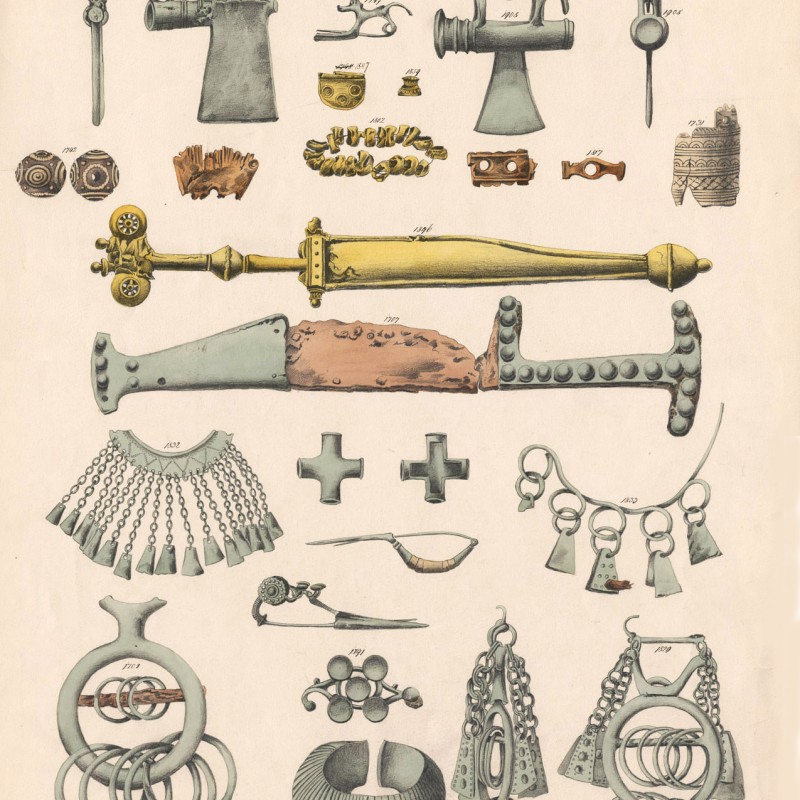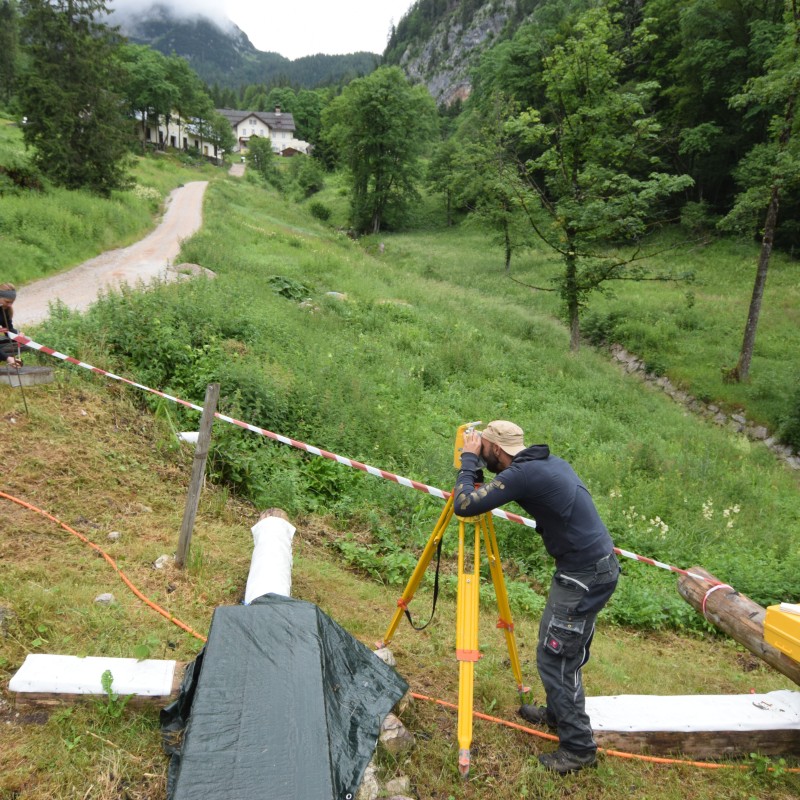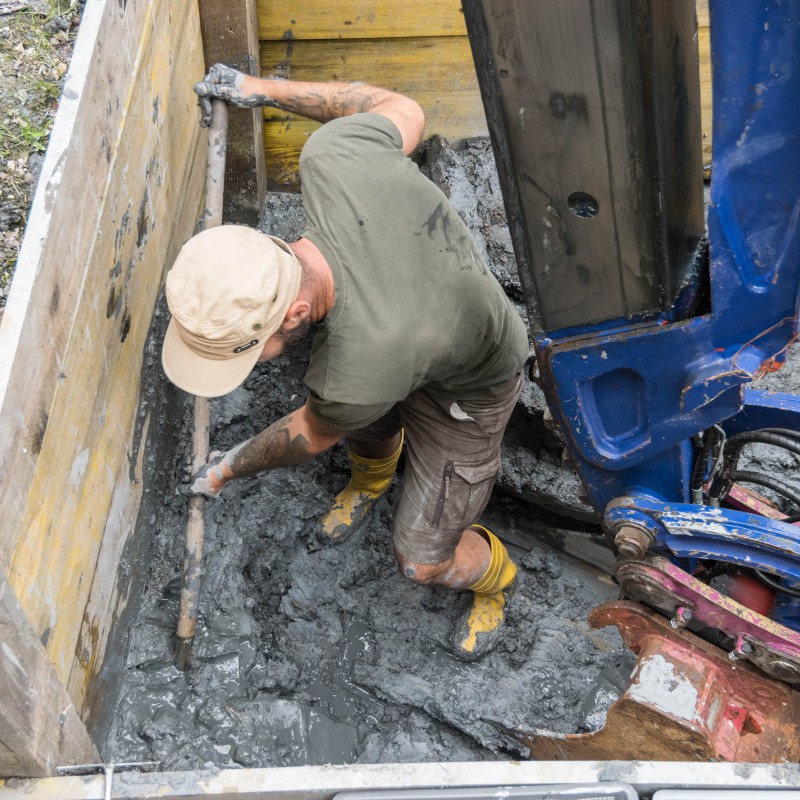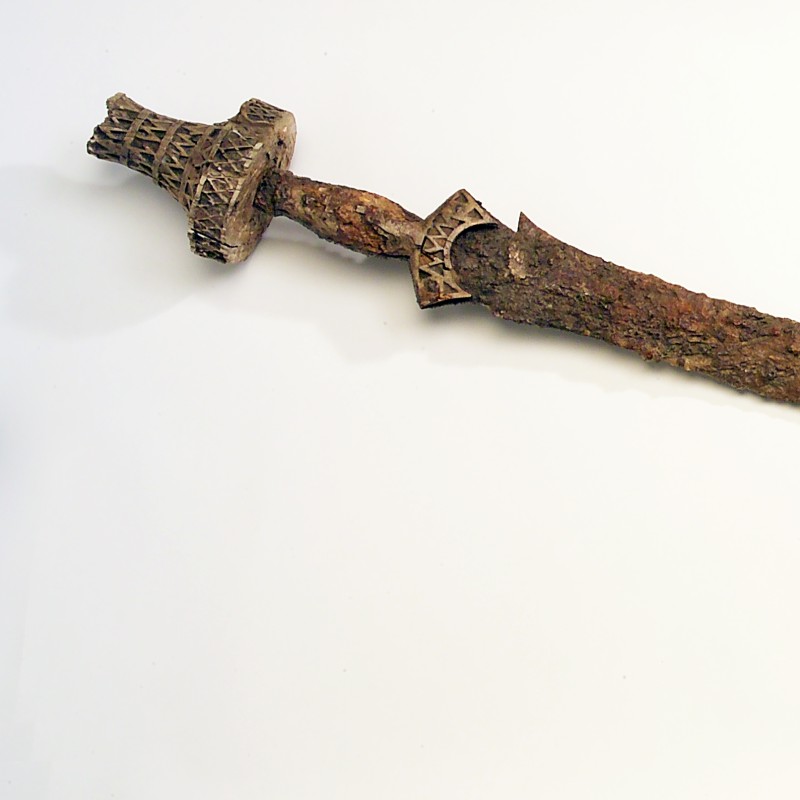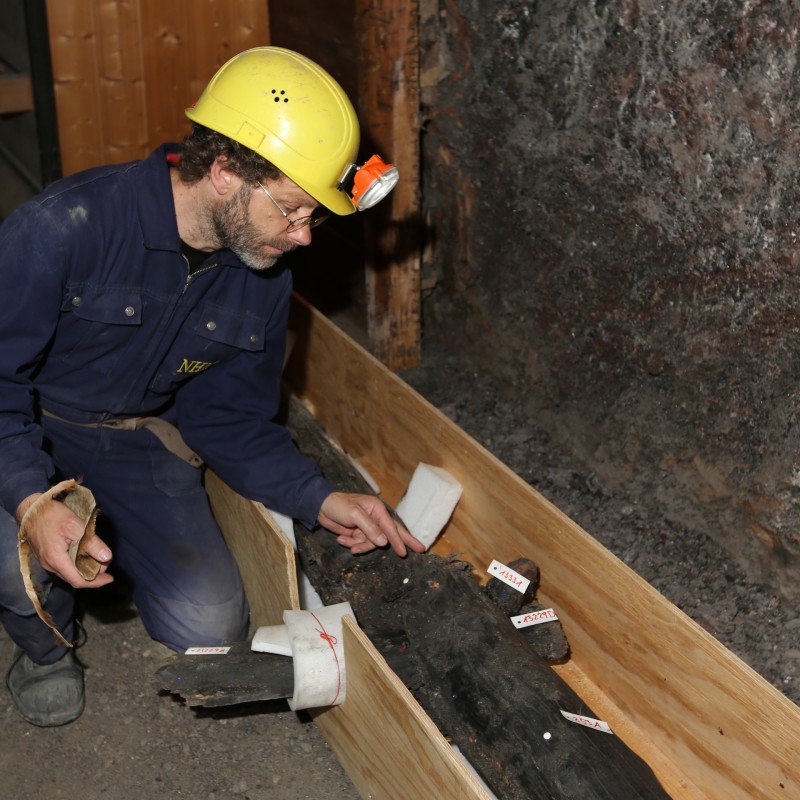Hallstatt 2023 – Research and Knowledge Transfer
30. May 2023
Ever since the establishment of
the Natural History Museum (NHM) Vienna in 1870, Hallstatt research has enjoyed close ties with the museum on Vienna's Ringstrasse
Boulevard. Between 1846 and 1863, the Hallstatt Iron Age burial ground was systematically investigated for the first time.
Under the NHM’s first director, Ferdinand von Hochstetter (1829-1884), further excavations from 1877 to 1878 unearthed burial
objects from 27 excavated graves that were then transferred to the new museum in Vienna. This Iron Age burial ground is currently
the venue of new investigations and the oldest known shaft in the prehistoric salt mine is now also accessible for research.
In the world of archaeology, Hallstatt, a small town at the foot of the Dachstein massif, has become famous for finds made
on a burial ground of the Early Iron Age (ca. 800 BC to 450 BC). These finds even led to the town’s name being applied to
an entire era on the European continent: the Hallstatt Culture. Next to the burial ground and its extraordinary wealth of
burial objects, the finds from the prehistoric salt mines have also gained world renown. Thanks to the good preservation conditions
in the salt mines, they cover an extremely wide range.
Currently, interdisciplinary research at the NHM’s Department of Prehistory, in cooperation with international research partners, is focusing not only on the burial ground and the mining facilities, but also on the economic system in the surrounding region.
New investigations on the burial ground
The construction of a sewer and a pressure pipeline at the northern edge of the known burial ground in 1993 and 1994 motivated the NHM’s Department of Prehistory to launch investigations alongside the construction activities. Since then, the Department has been conducting annual systematic work on site. The archaeological excavation season of the NHM Vienna begins every year in summer and continues into autumn.
The Upper Austrian authority in charge of torrent and avalanche control is currently erecting a barrier to protect the town of Hallstatt from rockfalls. This construction project runs across the Iron Age burial ground that was discovered in 1846 by the manager of the salt mine, Johann Georg Ramsauer (1795-1874), who then then conducted systematic archaeological investigations until 1863.
Ramsauer discovered around 1,000 graves with copious amounts of burial objects, most of which ended up in Vienna. Extensive protocols, grave descriptions and maps have survived from his excavations, as well as many watercolour plates with grave systems and types of finds. It was thanks to Ramsauer’s meticulous work, especially the precise records of the rich burial objects, that the site of the find became eponymous for an entire epoch of European cultural history, the Hallstatt Culture.
The archaeologists are now taking the current building project as an opportunity to reopen and review the 19th century investigations of the Iron Age burial ground.
“Since we assume that not all burials were recorded at that time, we would like to re-examine this zone,” explains Mag. Johann Rudorfer, research assistant at the Department of Prehistory and head of the above-ground research excavations of the NHM Vienna, who is responsible for the archaeological measures accompanying the construction of rockfall protection barriers in Hallstatt. “There is no clear information about the excavation method used at the time, and we can assume that we will still find remains of graves documented at the time.”
Although the sites were precisely documented in 19th century drawings, many of the finds of that time were probably left in the ground because they were not considered valuable then. The researchers now expect to find human remains and burial gifts such as ceramic vessels in this year's excavations. In the 19th century, pottery was only rarely removed from the ground because of its poor state of preservation.
Leading up to the excavations, the researchers did ground prospecting together with GeoSphere Austria in order to pinpoint the location of promising sites more precisely and thus improve coordination of the necessary activities. The prospecting is financed by Salinen Austria AG and the Federal Office for the Protection of Monuments, while the excavation activities are financed by the Torrent and Avalanche Control Department of the Federal Ministry of Agriculture, Forestry, Regions and Water. The NHM Vienna takes on the cost of finds administration, restoration and scientific processing of the excavation results.
The excavation work is scheduled to start on 30 May and continue until August 2023.
Hallstatt is not the only research venue. Evaluation of the “new” burial site finds recovered since 1993 and their respective status is continuing at the NHM in Vienna and has raised numerous new questions. “We need to examine whether the high occupancy rate of the graves found in the new excavations can also be confirmed for the area investigated in the 19th century. The same goes for identifying the original grave structure. There are numerous descriptions and beautiful watercolours, but these records are insufficient to determine whether the graves were exclusively flat or whether there were individual burial mounds raised above them,” explains Dr. Georg Tiefengraber, research assistant in the Department of Prehistory at the NHM Vienna and curator of the bronze and iron age collection. The new research may also unearth hitherto unknown burials sites. New insights gained from these activities could contribute significantly to knowledge about the Hallstatt Culture, the layout of the burial ground and the history of archaeological research.
Archaeological work in the salt mine
In 1960, the NHM’s Department of Prehistory began investigating the archaeological mining site. Traces recorded so far pertain mainly to Hallstatt and Bronze Age mining (1500 BC to 1000 BC) and allow an extraordinary insight into the life and work of prehistoric humans. The researchers investigate the organisation and mining techniques found underground. Due to the unique environmental conditions, organic materials in the Hallstatt salt mines have survived the millennia almost undamaged. As a result, we have numerous remains of tools and equipment, but also of sophisticated technical aids, which make it possible to reconstruct in great detail the work processes in prehistoric mining. The excavation of the prehistoric tunnels, which were closed over time by the pressure of the surrounding rock mass, also furnishes unique remains of food and clothing items of Bronze Age and Hallstatt Culture settlers.
Rehabilitation of the underground world heritage
“The prehistoric sites were discovered in the course of mining activities over the last 400 years during the construction of galleries and mining activities. Today, salt is mined in much deeper areas of the mountain and the galleries leading to the prehistoric mining areas are no longer necessary for current production and are becoming derelict. Once these tunnels are no longer accessible, the central part of the World Heritage Site will be lost,” explains Dr. Hans Reschreiter, research assistant at the NHM Vienna’s Department of Prehistory and head of the excavations and research in the prehistoric salt mine. In order to prevent this loss, a EUR 2 million renovation project was launched in 2018, funded by the province of Upper Austria, the Federal Ministry of Arts, Culture, Civil Service and Sport (BMKÖS), the Federal Office for the Protection of Monuments (BDA) and Salinen Austria AG, as well as the NHM Vienna. A few days ago, miners from Salinen Austria AG and archaeologists from the NHM Vienna were able to achieve an important milestone: the oldest known shaft structure dating back to the 12th century BC can now be accessed safely again.
Educational programme together with the Hallstatt Salt Worlds
Watching archaeologists work
3 July to 4 August 2023 - Monday to Thursday, 10:00 a.m. to 4:00 p.m.
Hallstatt 7000: Looking over the archaeologists' shoulders –above-ground excavations
Visit our excavations at the prehistoric burial ground. The scientists of the Natural History Museum Vienna will be happy to let you look over their shoulder and tell you about their exciting research work in the Hallstatt high valley, one of the most important archaeological sites of the early Iron Age, which is also called the “Hallstatt period”.
Free of charge.
Ticket prices for the Salzbergbahn funicular: Salzwelten Hallstatt: Opening hours & prices
Special guided tour “Prehistoric Expedition”
July & August, every Tuesday and Thursday at 10:00 a.m.
Explore the oldest salt mine in the world off the regular route for guided tours together with archaeologists. It’s a truly prehistoric expedition!
The 4-hour tour for insiders is suitable for children from the age of 10 and requires physical fitness and not being afraid in narrow tunnels. Adults: € 80, children (10 to 15 years): € 40
Registration required by mail: info@salzwelten.at or phone: 06132/200 2400
Archaeology on the mountain
16 and 17 September 2023 from 10:00 a.m. to 5:00 p.m.
Hands-on event for those keen to discover prehistory research
“Archaeological research – in the past and today”
Gain insights into the working methods of archaeologists from 175 years ago to the present day:
What were the methods used in Georg Ramsauer’s time to excavate, document and investigate a prehistoric burial ground and salt mine – and how is this done today?
Selected finds from the 2023 excavation campaign will be presented on site.
Free of charge.
Ticket prices for the Salzbergbahn funicular: Salzwelten Hallstatt: Opening hours & prices
Currently, interdisciplinary research at the NHM’s Department of Prehistory, in cooperation with international research partners, is focusing not only on the burial ground and the mining facilities, but also on the economic system in the surrounding region.
New investigations on the burial ground
The construction of a sewer and a pressure pipeline at the northern edge of the known burial ground in 1993 and 1994 motivated the NHM’s Department of Prehistory to launch investigations alongside the construction activities. Since then, the Department has been conducting annual systematic work on site. The archaeological excavation season of the NHM Vienna begins every year in summer and continues into autumn.
The Upper Austrian authority in charge of torrent and avalanche control is currently erecting a barrier to protect the town of Hallstatt from rockfalls. This construction project runs across the Iron Age burial ground that was discovered in 1846 by the manager of the salt mine, Johann Georg Ramsauer (1795-1874), who then then conducted systematic archaeological investigations until 1863.
Ramsauer discovered around 1,000 graves with copious amounts of burial objects, most of which ended up in Vienna. Extensive protocols, grave descriptions and maps have survived from his excavations, as well as many watercolour plates with grave systems and types of finds. It was thanks to Ramsauer’s meticulous work, especially the precise records of the rich burial objects, that the site of the find became eponymous for an entire epoch of European cultural history, the Hallstatt Culture.
The archaeologists are now taking the current building project as an opportunity to reopen and review the 19th century investigations of the Iron Age burial ground.
“Since we assume that not all burials were recorded at that time, we would like to re-examine this zone,” explains Mag. Johann Rudorfer, research assistant at the Department of Prehistory and head of the above-ground research excavations of the NHM Vienna, who is responsible for the archaeological measures accompanying the construction of rockfall protection barriers in Hallstatt. “There is no clear information about the excavation method used at the time, and we can assume that we will still find remains of graves documented at the time.”
Although the sites were precisely documented in 19th century drawings, many of the finds of that time were probably left in the ground because they were not considered valuable then. The researchers now expect to find human remains and burial gifts such as ceramic vessels in this year's excavations. In the 19th century, pottery was only rarely removed from the ground because of its poor state of preservation.
Leading up to the excavations, the researchers did ground prospecting together with GeoSphere Austria in order to pinpoint the location of promising sites more precisely and thus improve coordination of the necessary activities. The prospecting is financed by Salinen Austria AG and the Federal Office for the Protection of Monuments, while the excavation activities are financed by the Torrent and Avalanche Control Department of the Federal Ministry of Agriculture, Forestry, Regions and Water. The NHM Vienna takes on the cost of finds administration, restoration and scientific processing of the excavation results.
The excavation work is scheduled to start on 30 May and continue until August 2023.
Hallstatt is not the only research venue. Evaluation of the “new” burial site finds recovered since 1993 and their respective status is continuing at the NHM in Vienna and has raised numerous new questions. “We need to examine whether the high occupancy rate of the graves found in the new excavations can also be confirmed for the area investigated in the 19th century. The same goes for identifying the original grave structure. There are numerous descriptions and beautiful watercolours, but these records are insufficient to determine whether the graves were exclusively flat or whether there were individual burial mounds raised above them,” explains Dr. Georg Tiefengraber, research assistant in the Department of Prehistory at the NHM Vienna and curator of the bronze and iron age collection. The new research may also unearth hitherto unknown burials sites. New insights gained from these activities could contribute significantly to knowledge about the Hallstatt Culture, the layout of the burial ground and the history of archaeological research.
Archaeological work in the salt mine
In 1960, the NHM’s Department of Prehistory began investigating the archaeological mining site. Traces recorded so far pertain mainly to Hallstatt and Bronze Age mining (1500 BC to 1000 BC) and allow an extraordinary insight into the life and work of prehistoric humans. The researchers investigate the organisation and mining techniques found underground. Due to the unique environmental conditions, organic materials in the Hallstatt salt mines have survived the millennia almost undamaged. As a result, we have numerous remains of tools and equipment, but also of sophisticated technical aids, which make it possible to reconstruct in great detail the work processes in prehistoric mining. The excavation of the prehistoric tunnels, which were closed over time by the pressure of the surrounding rock mass, also furnishes unique remains of food and clothing items of Bronze Age and Hallstatt Culture settlers.
Rehabilitation of the underground world heritage
“The prehistoric sites were discovered in the course of mining activities over the last 400 years during the construction of galleries and mining activities. Today, salt is mined in much deeper areas of the mountain and the galleries leading to the prehistoric mining areas are no longer necessary for current production and are becoming derelict. Once these tunnels are no longer accessible, the central part of the World Heritage Site will be lost,” explains Dr. Hans Reschreiter, research assistant at the NHM Vienna’s Department of Prehistory and head of the excavations and research in the prehistoric salt mine. In order to prevent this loss, a EUR 2 million renovation project was launched in 2018, funded by the province of Upper Austria, the Federal Ministry of Arts, Culture, Civil Service and Sport (BMKÖS), the Federal Office for the Protection of Monuments (BDA) and Salinen Austria AG, as well as the NHM Vienna. A few days ago, miners from Salinen Austria AG and archaeologists from the NHM Vienna were able to achieve an important milestone: the oldest known shaft structure dating back to the 12th century BC can now be accessed safely again.
Educational programme together with the Hallstatt Salt Worlds
Watching archaeologists work
3 July to 4 August 2023 - Monday to Thursday, 10:00 a.m. to 4:00 p.m.
Hallstatt 7000: Looking over the archaeologists' shoulders –above-ground excavations
Visit our excavations at the prehistoric burial ground. The scientists of the Natural History Museum Vienna will be happy to let you look over their shoulder and tell you about their exciting research work in the Hallstatt high valley, one of the most important archaeological sites of the early Iron Age, which is also called the “Hallstatt period”.
Free of charge.
Ticket prices for the Salzbergbahn funicular: Salzwelten Hallstatt: Opening hours & prices
Special guided tour “Prehistoric Expedition”
July & August, every Tuesday and Thursday at 10:00 a.m.
Explore the oldest salt mine in the world off the regular route for guided tours together with archaeologists. It’s a truly prehistoric expedition!
The 4-hour tour for insiders is suitable for children from the age of 10 and requires physical fitness and not being afraid in narrow tunnels. Adults: € 80, children (10 to 15 years): € 40
Registration required by mail: info@salzwelten.at or phone: 06132/200 2400
Archaeology on the mountain
16 and 17 September 2023 from 10:00 a.m. to 5:00 p.m.
Hands-on event for those keen to discover prehistory research
“Archaeological research – in the past and today”
Gain insights into the working methods of archaeologists from 175 years ago to the present day:
What were the methods used in Georg Ramsauer’s time to excavate, document and investigate a prehistoric burial ground and salt mine – and how is this done today?
Selected finds from the 2023 excavation campaign will be presented on site.
Free of charge.
Ticket prices for the Salzbergbahn funicular: Salzwelten Hallstatt: Opening hours & prices


